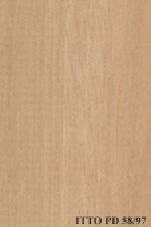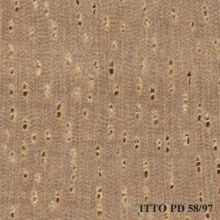
PERILLO (Couma macrocarpa)
Trade Name
Perillo
Scientific Name
Couma macrocarpa Barb. Rodr.
Family
APOCYNACEAE
Common Names
Vacahosca; Perillo Negro; Leche Caspi (Peru); Dukaballi; Cumá assú (Brazil); Cuma Assu (Brazil); Avichuri; Ama Apa (Brazil); Popa; Perillo; Pendare; Palo De Vaca; Melkboom; Vaca Hosca; Sorva; Purva; Nienye; Juan Soco; Guaimaro Macho; Couma; Avichure; Milk Tree; Cow Tree
Scientific Name Synonyms
Couma guatemalensis Standl.; Couma caurensis Pittier; Couma capiron Pittier
Description Of The Tree
Botanical Description
It is a large tree, with lengths of 30 to 40 m and up to 100 cm of diameter, with no buttresses. It has abundant creamy latex.
Natural Habitat
C. macrocarpa grows usually on well drained lowland sites, in the rain forests of tropical America.
Natural Distribution
It is reported from Guatemala, south to Brazil and Peru.
Non Timber Uses
The latex of this species is used in the manufacture of chewing gum. The fruits are edible.
Wood Identification
Anatomic Description Of Wood
Wood diffuse porous. Vessels in radial multiples of 2 to 4. Tangential diameter of vessel lumina 150 to 200 micras (medium). Occasionally white deposits in heartwood vessels. Vessels per mm2 6 to 10 (medium). Occasionally vessels per mm2 less than 6. Simple per Apotracheal axial parenchyma diffuse and/or diffuse in aggregates. Axial parenchyma in continuous tangential lines (included in reticulate and scalariform). 5 to 8 cells per parenchyma strand. 4 to 10 rays per mm (medium). Rays commonly 2 seriate. Prismatic crystals in radial alignment in procumbent ray cells (chambered cells). Prismatic crystals in the ray cells. Homogeneous rays and/or sub-homogeneous rays (all ray cells procumbent). Fibers with distinctly bordered pits.
-
 Wood Macro Photo Tangential Plane
Wood Macro Photo Tangential Plane
-
 Wood Micro Photo Of Transversal Section
Wood Micro Photo Of Transversal Section
Availability
Cites Status
Unrestricted
General Wood Description
Odor
Dry wood has no characteristic odor or taste.
Color
The sapwood is not differentiated, the heartwood is reddish yellow when dry.
Grain
The grain is reported to be straight or interlocked.
Texture
The wood is typically medium in texture.
Luster
The wood surface is described as moderate in luster.
Natural Durability
The heartwood is susceptible to blue staining fungi.
Natural durability index (1= Very high durability, 7=Vey low durability)
5
Resistance To Impregnation
Impregnation of this species is presumably easy.
Wood Physical Properties
Basic Density or Specific Gravity (O.D. weight/vol. green) (g/cm³)
0.56
Air-dry Density (Weight and volume at 12%MC) (g/cm³)
0.61
Total shrinkage Tangential (Saturated to 0%MC) (%)
6.4
Total shrinkage Radial (Saturated to 0%MC) (%)
3.9
Dimensional stability ratio (Total Tangential Shrinkage %/Total Radial Shrinkage %)
1.6
Wood Chemical Properties
Wood Mechanical Properties
Bending Strength (MOR),12%MC (kgf/cm²)
1150
Compression parallel to fiber 12%MC (kgf/cm²)
594
Shear strength radial 12%MC (kgf/cm²)
84
Janka hardness (side) 12%MC (kgf)
445
Janka hardness (end grain) 12%MC (kgf)
595
Workability
Rotary Veneer Cutting
This species is interesting for lamination.
Sliced Veneer
This species is interesting for lamination.
Machining
Wood processing is reported to be easy.
Planing
It is easy to plane, but difficult when interlocked grain is present in the quarter-sawn surfaces.
Nailing
This species is reported to have a good nailing behavior.
Sanding
Wood of this species is easy to sand.
Finishing
Wood of this species gives a good finish, but it may pose some difficulties on quarter sawn stock.
REFERENCED USES
End Uses Summary
HOUSING GENERAL, beams, joists, flooring, steps, FURNITURE AND CABINETS, PLYWOOD AND VENEER, PACKING, light packing
General Housing
- 10 - Silica in Timbers
Beams
- 11 - Prospect: The wood database
Joists
- 12 - Tropical timbers of the world. Part I-Tropical American Species
Flooring
- 14 - Handbook of Hardwoods
Steps
- 17 - Tree Conservation Database
Furniture Cabinets
- 21 - Tropical timbers of the world. Part III-Southeast Asian and Oceanian Species.
Panels, Veneers
- 25 - Directory of Timber Trade Malaysia
Packing
- 45 - Recopilación y Análisis de Estudios Tecnológicos de Maderas Peruanas
Light Packing
- 46 - ECUADOR, Inventario y Aprovechamiento de los Bosques del Sur Ecuatoriano
Please Provide Information To View Producer Information